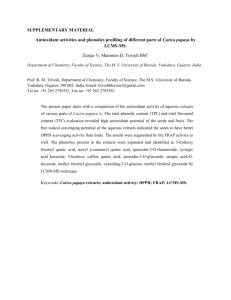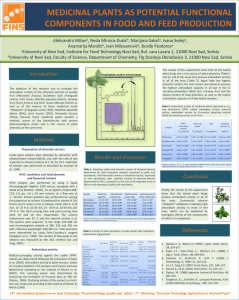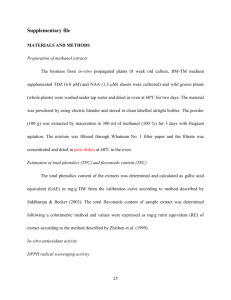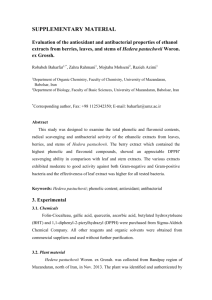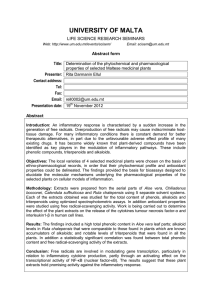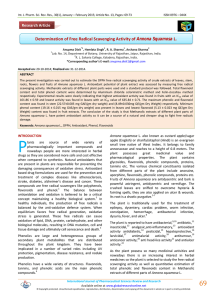Document 13309888
advertisement
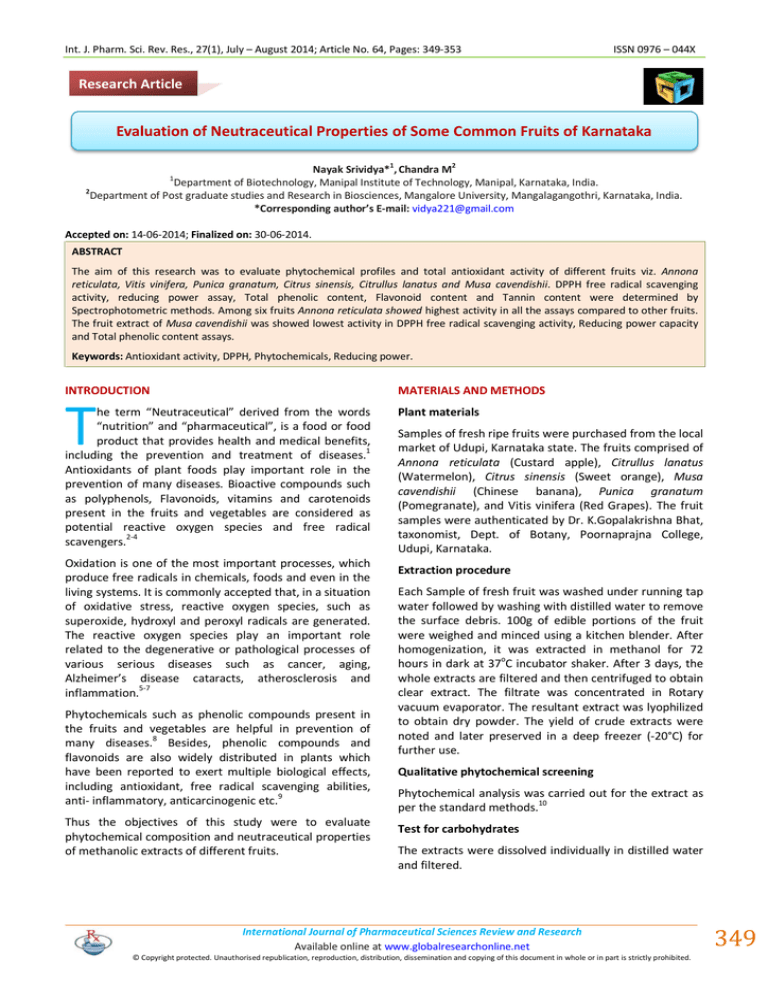
Int. J. Pharm. Sci. Rev. Res., 27(1), July – August 2014; Article No. 64, Pages: 349-353 ISSN 0976 – 044X Research Article Evaluation of Neutraceutical Properties of Some Common Fruits of Karnataka 1 2 Nayak Srividya* , Chandra M Department of Biotechnology, Manipal Institute of Technology, Manipal, Karnataka, India. 2 Department of Post graduate studies and Research in Biosciences, Mangalore University, Mangalagangothri, Karnataka, India. *Corresponding author’s E-mail: vidya221@gmail.com 1 Accepted on: 14-06-2014; Finalized on: 30-06-2014. ABSTRACT The aim of this research was to evaluate phytochemical profiles and total antioxidant activity of different fruits viz. Annona reticulata, Vitis vinifera, Punica granatum, Citrus sinensis, Citrullus lanatus and Musa cavendishii. DPPH free radical scavenging activity, reducing power assay, Total phenolic content, Flavonoid content and Tannin content were determined by Spectrophotometric methods. Among six fruits Annona reticulata showed highest activity in all the assays compared to other fruits. The fruit extract of Musa cavendishii was showed lowest activity in DPPH free radical scavenging activity, Reducing power capacity and Total phenolic content assays. Keywords: Antioxidant activity, DPPH, Phytochemicals, Reducing power. INTRODUCTION MATERIALS AND METHODS T he term “Neutraceutical” derived from the words “nutrition” and “pharmaceutical”, is a food or food product that provides health and medical benefits, including the prevention and treatment of diseases.1 Antioxidants of plant foods play important role in the prevention of many diseases. Bioactive compounds such as polyphenols, Flavonoids, vitamins and carotenoids present in the fruits and vegetables are considered as potential reactive oxygen species and free radical scavengers.2-4 Oxidation is one of the most important processes, which produce free radicals in chemicals, foods and even in the living systems. It is commonly accepted that, in a situation of oxidative stress, reactive oxygen species, such as superoxide, hydroxyl and peroxyl radicals are generated. The reactive oxygen species play an important role related to the degenerative or pathological processes of various serious diseases such as cancer, aging, Alzheimer’s disease cataracts, atherosclerosis and inflammation.5-7 Phytochemicals such as phenolic compounds present in the fruits and vegetables are helpful in prevention of 8 many diseases. Besides, phenolic compounds and flavonoids are also widely distributed in plants which have been reported to exert multiple biological effects, including antioxidant, free radical scavenging abilities, anti- inflammatory, anticarcinogenic etc.9 Thus the objectives of this study were to evaluate phytochemical composition and neutraceutical properties of methanolic extracts of different fruits. Plant materials Samples of fresh ripe fruits were purchased from the local market of Udupi, Karnataka state. The fruits comprised of Annona reticulata (Custard apple), Citrullus lanatus (Watermelon), Citrus sinensis (Sweet orange), Musa cavendishii (Chinese banana), Punica granatum (Pomegranate), and Vitis vinifera (Red Grapes). The fruit samples were authenticated by Dr. K.Gopalakrishna Bhat, taxonomist, Dept. of Botany, Poornaprajna College, Udupi, Karnataka. Extraction procedure Each Sample of fresh fruit was washed under running tap water followed by washing with distilled water to remove the surface debris. 100g of edible portions of the fruit were weighed and minced using a kitchen blender. After homogenization, it was extracted in methanol for 72 hours in dark at 37oC incubator shaker. After 3 days, the whole extracts are filtered and then centrifuged to obtain clear extract. The filtrate was concentrated in Rotary vacuum evaporator. The resultant extract was lyophilized to obtain dry powder. The yield of crude extracts were noted and later preserved in a deep freezer (-20°C) for further use. Qualitative phytochemical screening Phytochemical analysis was carried out for the extract as per the standard methods.10 Test for carbohydrates The extracts were dissolved individually in distilled water and filtered. International Journal of Pharmaceutical Sciences Review and Research Available online at www.globalresearchonline.net © Copyright protected. Unauthorised republication, reproduction, distribution, dissemination and copying of this document in whole or in part is strictly prohibited. 349 © Copyright pro Int. J. Pharm. Sci. Rev. Res., 27(1), July – August 2014; Article No. 64, Pages: 349-353 ISSN 0976 – 044X Benedict’s test Evaluation of in vitro antioxidant activity The filtrates were treated individually with 2 ml of Benedict’s reagent and heated gently. Orange red precipitate indicates the presence of reducing sugars. DPPH radical scavenging activity Test for proteins Xanthoproteic Test The aqueous extracts were individually treated with few drops of conc. Nitric acid. Formation of yellow colour indicates the presence of proteins. Biuret test To the 2ml of the each extract few drops of 2% copper sulfate solution was added and 1 ml of (95%) ethanol, followed by excess KOH pellets. Formation of pink colour indicates the presence of proteins.11 DPPH free radical scavenging assay is based on the concept that a hydrogen donor is an antioxidant. DPPH• is deep purple colour in the solution, which turn yellow due to the presence of antioxidant in the sample.16 The different concentrations of extract in methanol were taken in a series of test tubes containing 3ml of 0.1mM methanolic solution of DPPH. The tubes were shaken vigorously and allowed to stand for 30min at room temperature in dark. Absorbances of samples were measured at 520nm against control. Ascorbic acid was used as the standard control. All the tests were performed in triplicates. Test for amino acids Free radical scavenging activity was expressed as inhibition percentage and was calculated using the following formula: Ninhydrin Test % Inhibition = (Control O.D – Sample O.D) X 100 To the each extract, 1ml of ninhydrin reagent was added and boiled for few minutes. Formation of blue colour indicates the presence of amino acids.12 Test for Saponins Foam Test 0.1 gm of extract was shaken with 2 ml of water. If foam produced persist while warming indicates the presence of saponins.13 Test for cardiac glycosides Keller – killani test Each extracts were treated with 2ml of glacial acetic acid and 2 drops of ferric chloride solution. The mixture was then poured into another test tube containing 2 ml of concentrated sulphuric acid. A brown ring at the interphase indicates the presence of cardiac glycosides14. Test for steroids Each extracts were treated with 1ml of chloroform and 1ml of concentrated sulphuric acid. A reddish brown colour produced in the lower chloroform layer indicates the presence of steroids.13, 15 Test for flavonoids Each extracts were treated with 0.5ml of ammonia solution and 0.5 ml of concentrated sulphuric acid. A yellow coloration observed indicates the presence of 13 flavonoids. Test for terpenoids Control O.D Total antioxidant capacity This assay is based on the reduction of Mo (VI) to Mo (V) by the sample analyte and the subsequent formation of green phosphate/ Mo (V) complex at acidic pH.17 Methanol extract is added into a series of eppendorf tube containing methanol and mixed with 1ml of Phosphomolybdenum reagent solution. The tubes were incubated for 90min at 95⁰C in dry bath. The mixture was cooled to room temperature and the absorbance was read at 695nm against blank. The experiment was conducted in triplicates and values are expressed as (µg) equivalents of ascorbic acid/mg of extract. Reducing power assay The reduction of ferric/ferricyanide complex to the ferrous form is monitored by measuring the formation of Pearl’s Prussian blue at 700nm.18 Different concentrations of methanol extracts were prepared in methanol solvent and diverse with 2.5ml of 0.2M phosphate buffer and 2.5ml of freshly prepared 1% K3Fe (CN) 6. This mixture was incubated at 50oC for 20 min, 2.5ml of 10% TCA was added and centrifuged at 3000rpm for 10min. 2.5ml of the supernatant was assorted with 2.5ml of methanol and 0.5ml of 0.1% FeCl3, and the absorbance was measured at 700nm. The experiment was conducted in triplicates and the reducing power was expressed as (µg) equivalents of ascorbic acid / mg of extract. Bioactive compounds Total phenolic content Salkowski’s test Each extracts were treated with 1ml of chloroform and 2ml of concentrated sulphuric acid carefully added to form a layer. A reddish brown coloration of the interphase was formed indicates the presence of terpenoids. The quantification of total phenolic compounds was determined by spectrophotometer, using the FolinCiocalteau reagent, according to the methodology described by Singleton and Rossi (1965).19 0.1 ml of sample was made up to 0.25 ml with distilled water and mixed with 0.25ml of Folin Ciocalteu's phenol reagent. International Journal of Pharmaceutical Sciences Review and Research Available online at www.globalresearchonline.net © Copyright protected. Unauthorised republication, reproduction, distribution, dissemination and copying of this document in whole or in part is strictly prohibited. 350 © Copyright pro Int. J. Pharm. Sci. Rev. Res., 27(1), July – August 2014; Article No. 64, Pages: 349-353 After 3 min, 0.5 ml of 20% sodium carbonate solution was added to the mixture and made up to 5 ml by adding distilled water. The reaction mixture was kept in the dark for 30 min, after which its absorbance were read at 760 nm. All the tests were performed in triplicates. The results were expressed as (µg) equivalents of Ferulic acid /mg of extract. ISSN 0976 – 044X was expressed as (µg) equivalents of catechin /mg of sample. Tannin content The tannin content in sample was estimated by the 21 method of (Price and butler) with slight modifications. 0.020ml of the sample is added into a test tube containing 0.980 ml of distilled water. 0.5 ml of 1% K3 Fe (CN) 6 and 0.1 ml of 1 % FeCl3 were added and was made up to 3 ml with distilled water. After 10 min the solutions were measured spectrophotometrically at 720nm. All the tests were performed in triplicates. Flavonoid content The quantification of total flavonoid compounds was determined by spectrophotometer, according to the methodology described Jia et al (1999).20 0.1 ml of the sample is added into a test tube containing 0.4 ml of distilled water. Then added 0.075ml of 5% sodium nitrite solution and allowed to stand for 5 min. Added 0. 15 ml of 10% aluminium chloride, after 6 min 1 ml of 1.0 M sodium hydroxide were added and the mixture were diluted with another 2.275 ml of distilled water. The absorbance of the mixture at 512nm was measured immediately. All the tests were performed in triplicates. The flavonoid content RESULTS AND DISCUSSION Qualitative phytochemical analysis revealed that the presence of carbohydrates, proteins, amino acids, glycosides, steroids, terpenoids and Flavonoids in all the fruit extracts. Analysis also revealed negative results for Saponins in all the methanol fruit extracts. The results were displayed in the Table 1. Table 1: Qualitative phytochemical analysis of six methanol fruit extracts Fruit Extracts Tests Annona reticulata Vitis vinifera Punica granatum Citrus sinensis Citrullus lanatus Musa cavendishii Carbohydrates + + + + + + Proteins + + + + + + Amino acids + + + + + + Saponins _ _ _ _ _ _ Cardiac glycosides + + + + + + Steroids + + + + + + Terpenoids + + + + + + Flavonoids + + + + + + DPPH radical scavenging activity The free radical scavenging activity of six fruit extracts were analyzed. All fruit extracts exhibited free radical scavenging activity with IC50 values between 100µg/ml to 5mg /ml. DPPH free radical scavenging activity was found to be highest in A. reticulata followed by V.vinifera, P.granatum, C. sinensis, C.lanatus and M.cavendishii and IC50 values were 114µg/ml, 229µg/ml, 313µg/ml, 731µg/ml, 2.47mg/ml and 4.81mg/ml respectively. IC50 value for the standard Ascorbic acid was found to be 2.52µg/ml (Figure 1). Lower value of IC50 indicates higher antioxidant activity. The antioxidant activity of the substances was analyzed using the stable radical of DPPH, measured as decolorizing effect following the trapping of the impaired electrons of DPPH.22 Total antioxidant capacity The total antioxidant activity was found to be highest in A.reticulata followed by P.granatum, V.vinifera, C.lanatus, M.cavendishii and C.sinensis and the values were 57.71µg/mg, 52.10µg/mg, 47.71µg/mg, 36.11µg/mg, 30.18µg/mg, and 22.96µg/mg of the extract respectively. The total antioxidant activity was expressed as (µg) equivalents of ascorbic acid/ mg of the extract. Results of antioxidant capacity of the six fruit extract were represented graphically in Figure 2. It is proved that most of the antioxidant activity of plants is derived from phenols.23 Structurally, phenols comprise an aromatic ring bearing one or more hydroxyl substituent’s. The antioxidant activity of this type of molecule is due to their ability to scavenge free radicals, donate hydrogen atoms or electrons or chelate metal cations.24 Reducing power assay Figure 3 shows the reducing power capacity of six common fruit extracts. Reducing power capacity of different fruit extract was expressed as (µg) equivalents of ascorbic acid/mg of the extract. In reducing power assay the values were 26.09µg/mg, 19.03µg/mg, 14.31µg/mg, 3.04µg/mg, 2.28µg/mg and 1.3µg/mg of International Journal of Pharmaceutical Sciences Review and Research Available online at www.globalresearchonline.net © Copyright protected. Unauthorised republication, reproduction, distribution, dissemination and copying of this document in whole or in part is strictly prohibited. 351 © Copyright pro Int. J. Pharm. Sci. Rev. Res., 27(1), July – August 2014; Article No. 64, Pages: 349-353 ISSN 0976 – 044X extract in A.reticulata followed by V.vinifera, P.granatum, C.sinensis, C.lanatus and M.cavendishii respectively. Figure 4: Total phenolic contents of six common fruit extracts Figure 1: DPPH radical scavenging activity of six common fruit extracts in terms of IC50 values Figure 2: Total antioxidant activity of six common fruit extracts. Flavonoid content The values of total flavonoid content were 5.18µg/mg, 1.7µg/mg, 1.14µg/mg, 0.316µg/mg, 0.086µg/mg and 0.027µg/mg of the extract in V.vinifera followed by A. reticulata, P.granatum, C.sinensis, M.cavendishii and C.lanatus respectively. The results of total flavonoid content of the extracts were displayed in Fig.5. Naturally occurring polyphenolic compounds such as flavonoids, ubiquitously found in plants.27 Some flavonoids can behave as both antioxidants and prooxidants, depending on concentration and the redox environment present. Prooxidant activity of certain flavonoids, which acts as antioxidants against free radicals are yet to be demonstrated in the presence of some transition metal such as Cu2+(Cuprous ion).28 Total phenolic content Total Phenol contents were found to be highest in A.reticulata followed by V.vinifera, P.granatum, C.sinensis C.lanatus and M.cavendishii and values were 39.3µg, 33.08µg, 20.34µg, 10.8µg, 6.08µg and 2.76 µg/mg of the extract respectively. The results of total phenolic content of the extracts were displayed in Figure 4. It is previously Known that the phenolic compounds acts as free radical oxidation terminators and have been known to show medicinal activity as well as for exhibiting physiological 25,26 functions. Figure 5: Flavonoid contents of six common fruit extracts. Tannin content The results of total tannin content of the extracts were represented graphically in Figure 6. Figure 3: Reducing power capacity of six common fruit extracts. The tannin content was expressed as (µg) equivalents of catechin / mg of extract. The tannin content was present in all the fruit extracts and the values ranging between 0.2µg to 12µg /mg of the fruit extracts. Total Tannin contents were found to be highest in A.reticulata followed by V.vinifera, P.granatum, M.cavendishii, C.sinensis and C.lanatus and values were 11.83µg, 8.66µg, 7.81µg, 1.00µg, 0.66µg and 0.21µg per mg of the extracts respectively. International Journal of Pharmaceutical Sciences Review and Research Available online at www.globalresearchonline.net © Copyright protected. Unauthorised republication, reproduction, distribution, dissemination and copying of this document in whole or in part is strictly prohibited. 352 © Copyright pro Int. J. Pharm. Sci. Rev. Res., 27(1), July – August 2014; Article No. 64, Pages: 349-353 9. ISSN 0976 – 044X Miller AL, Antioxidant flavonoids: structure, function and clinical usage, Alternative Medicine Review, 1, 1996, 103. 10. Harborn JB, Phytochemical methods, London. Chapman and Hall, Ltd. 1973. 49-188. 11. Gahan PB, Plant histochemistry and cytochemistry: introduction. Academic press, Florida, U.S.A, 1984, 301. An 12. Yasuma A, Ichikawa T, Ninhydrin-Schiff and Alloxan- Schiff staining methods for proteins, Journal of Laboratory and Clinical Medicine, 41(2), 1953, 296-299. 13. Sofowora A, Screening Plants for Bioactive Agents In: Medicinal Plants and Traditional Medicinal in Africa, 2nd Ed. Spectrum Books Ltd, Sunshine House, Ibadan, Nigeria, 1993, 134-156. Figure 6: Tannin contents of six common fruit extracts CONCLUSION Among six common fruits, Annona reticulata exhibit highest activity in all the assays compared to other fruits. In DPPH assay, free radical scavenging activity was found to be highest in Annona reticulata followed by Vitis vinifera, Punica granatum, Citrus sinensis, Citrullus lanatus and Musa cavendishii. The same order was seen in Total phenolic content and reducing power assay of six methanolic fruit extracts. Hence the study revealed that, Annona reticulata is a super fruit compared to other five fruits. Acknowledgement: The authors are thankful to Chancellor, Vice chancellor and Registrar of Manipal University for providing lab facilities and encouragement. We are also thankful to Chancellor, Vice chancellor and Registrar of Mangalore University for their co-operation in the research work. REFERENCES 1. Kalra EK, “Nutraceutical – definition and introduction”, AAPS Pharmasci, 5 (3), 2003, 27-28. 2. Rice-Evans CA, Miller NJ, Bolwell PG, Bramley PM, Pridham JB, The relative antioxidant activities of plant-derived polyphenolic flavonoids, Free Radical Research, 22, 1995, 375-383. 3. Barberousse H, Roiseux O, Robert C, Paquot M, Deroanne C and Blecker C, Analytical methodologies for quantification of ferulic acid and its oligomers. Journal of the Science of Food and Agriculture, 88, 2008, 1494-1511. 4. Gey KF, The Antioxidant Hypothesis of Cardiovascular-DiseaseEpidemiology and Mechanisms, Biochemical Society Transactions, 18, 1990, 1041-1045. 5. Diaz MN, Frei B, Vita JA, Keaney JF, Antioxidants and atherosclerotic heart disease, The New England journal of Medicine, 337, 1997, 408‐416. 6. Burns J, Gardner PT, Matthews D, Duthie GG, Lean ME, Crozier A, Extraction of phenolics and changes in antioxidant activity of red wines during vinification, Journal of Agricultural and Food Chemistry, 49, 2001, 5797‐5808. 7. Smith MA, Perry G, Richey PL, Sayre LM, Anderson VE, Beal MF, Oxidative damage in Alzheimer’s, Nature, 382, 1996, 120‐121. 8. Naczk M, Shahidi F, Phenolics in cereals, fruits and vegetables: Occurrence, extraction and analysis, Journal of Pharmaceutical and Biomedical Analysis, 41, 2006, 1523–1542. 14. Trease GE, Evans WC, Pharmacognosy, 11th Ed, Brailliar Tiridel Can. Macmillan Publishers, London, 1989. 15. Trease GE, Evans WC, Pharmacognosy, 15th Ed, Saunders Publishers, London, 2002, 42-44, 221-229, 246-249, 304-306, 331332, 391-393. 16. Wong SP, Lai PL, Jen HWK, Antioxidant activities of aqueous extracts of selected plants, Food Chemistry, 99, 2006, 775‐783. 17. Prieto P, Pineda M, Aguilar M, Spectrophotometric quantitation of antioxidant capacity through the formation of phosphomolybdenum complex: specific application to determination of vitamin E, Analytical Biochemistry, 269, 1999, 337-341. 18. Oyaizu M, Studies on products of browning reaction prepared from glucosamine, Japanese Journal of Nutrition, 44, 1986, 307–315. 19. Singleton VL, Rossi JA, Calorimetry of total phenolics with phosphomolybdic-phosphotungtic acid reagent, American Journal of Enology and Viticulture, 16, 1965, 144-158. 20. Jia ZS, Tang MC, Wu JM, The determination of Flavonoid contents in mulberry and their scavenging effects on superoxide radicals, Food Chemistry, 64, 1999, 555-559. 21. Price ML, Butler LG, Rapid visual estimation and Spectrophotometric determination of tannin content of sorghum grain, Journal of Agricultural and Food Chemistry, 25, 1977, 12681273. 22. Von Gadow A, Joubert E, Hansmann CF, Comparison of the antioxidant activity of aspalathin with that of other plant phenols of rooibos tea (Aspalathus linearis), α- tocopherol, BHT and BHA, Journal of Agricultural and Food Chemistry, 45(3), 1997, 632–638. 23. Mansouri A, Embared G, Kokkalou E, Kefalas P, Phenolic profile and antioxidant activity of the Algerian ripe date palm fruit (Phoenix dactylifera), Food chemistry, 89, 2005, 411-420. 24. Amarowicz R, Pegg RB, Rahimi M, Barl B, Weil JA, Free radical scavenging capacity and antioxidant activity of selected plant species from the Canadian prairies, Food chemistry, 84, 2004, 551562. 25. Shahidi F, Wanasundara JPD, Phenolic antioxidants, Critical Reviews in Food Science and Nutrition, 21, 1992, 67-103. 26. Sofowora A, Medicinal Plants and Traditional Medicinal in Africa, 2nd Ed. Spectrum Books Ltd, Sunshine House, Ibadan, Nigeria, 1993, 289. 27. Carlo Di G, Mascolo N, Izzo AA, Capasso F, Flavonoids: Old and new aspects of a class of natural therapeutic drugs, Life Sciences, 65, 1999, 337-353. 28. Cao G, Sofic E, Prior RL, Antioxidant and prooxidant behavior of flavonoids, Free Radical Biology and Medicine, 22(5), 1997, 749760. Source of Support: Nil, Conflict of Interest: None. International Journal of Pharmaceutical Sciences Review and Research Available online at www.globalresearchonline.net © Copyright protected. Unauthorised republication, reproduction, distribution, dissemination and copying of this document in whole or in part is strictly prohibited. 353 © Copyright pro

